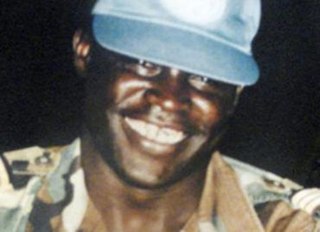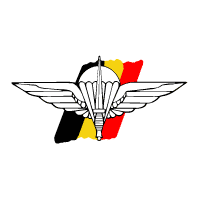
A paratrooper is a military parachutist—someone trained to parachute into a military operation, and usually functioning as part of an airborne force. Military parachutists (troops) and parachutes were first used on a large scale during World War II for troop distribution and transportation. Paratroopers are often used in surprise attacks, to seize strategic objectives such as airfields or bridges.

The Commandos Marine are the Special Operation Forces (SOF) of the French Navy. The Commandos Marine are nicknamed Bérets Verts. They operate under the Naval Riflemen and Special Operations Forces Command (FORFUSCO) and form part of the French Special Operations Command.

The United Nations Assistance Mission for Rwanda (UNAMIR) was established by United Nations Security Council Resolution 872 on 5 October 1993. It was intended to assist in the implementation of the Arusha Accords, signed on 4 August 1993, which was meant to end the Rwandan Civil War. The mission lasted from October 1993 to March 1996. Its activities were meant to aid the peace process between the Hutu-dominated Rwandese government and the Tutsi-dominated rebel Rwandan Patriotic Front (RPF). The UNAMIR has received much attention for its role in failing, due to the limitations of its rules of engagement, to prevent the Rwandan genocide and outbreak of fighting. Its mandate extended past the RPF overthrow of the government and into the Great Lakes refugee crisis. The mission is thus regarded as a major failure.

A parachutist badge is a military badge awarded by the armed forces of many states to soldiers who have received parachute training and completed the required number of jumps. It is difficult to assess which country was the first to introduce such an award.

The failure of the international community to effectively respond to the Rwandan genocide of 1994 has been the subject of significant criticism. During a period of around 100 days, between 7 April and 15 July, an estimated 500,000-1,100,000 Rwandans, mostly Tutsi and moderate Hutu, were murdered by Interahamwe militias.

Mbaye Diagne was a Senegalese military officer who served in Rwanda as a United Nations military observer from 1993 to 1994. During the Rwandan genocide he undertook many missions on his own initiative to save the lives of civilians.
François-Xavier Nzuwonemeye is a former Rwandan soldier, who is chiefly known for his role in the Rwandan genocide.

The 1er Régiment de Parachutistes d'Infanterie de Marine or 1er RPIMa is a unit of the French Army Special Forces Command, therefore part of the Special Operations Command.

The maroon beret in a military configuration has been an international symbol of airborne forces since the Second World War. It was first officially introduced by the British Army in 1942, at the direction of Major-General Frederick "Boy" Browning, commander of the British 1st Airborne Division. It was first worn by the Parachute Regiment in action in North Africa during November 1942.

The 2nd Marine Infantry Parachute Regiment is an airborne regiment of the French Army created in 1947. The regiment is heir to the traditions of the 2nd Colonial Commando Parachute Battalion 2eB.C.C.P. As of 2008, the regiment is stationed at Saint-Pierre, Réunion.

The 3rd Marine Infantry Parachute Regiment is an airborne elite regiment of the French Army heir to the 3rd Colonial Commando Parachute Battalion 3e BCCP created in 1948 and the 3rd Colonial Parachute Regiment 3e RPC. The regiment is part of the 11th Parachute Brigade.

The Free Belgian forces were soldiers from Belgium and its colonies who fought as part of the Allied armies during World War II, after the official Belgian surrender to Nazi Germany. It is distinct from the Belgian Resistance which existed in German-occupied Belgium.

The Special Operations Regiment is a regiment of the Land Component of the Belgian Armed Forces. Its headquarters is located in Heverlee. It was known as the Light Brigade until 3 July 2018 when it was renamed. The Special Operations Regiment is Belgium's special operations and rapid response unit.
1er Bataillon de Fusiliers Marins Commandos was a Fusiliers Marins commando unit of the Free French Navy, raised in 1942, which served during the Second World War. Its initial Commandant was then-Lieutenant de Vaisseau (Captain) Philippe Kieffer of the Free French Navy, under whose command they participated in the Normandy landings in 1944.

Troops began wearing berets as a part of the headgear of military uniforms in some European countries during the 19th century; since the mid-20th century, they have become a component of the uniforms of many armed forces throughout the world. Military berets are usually pushed to the right to free the shoulder that bears the rifle on most soldiers, but the armies of some countries, mostly within Europe, South America, and Asia, have influenced the push to the left.

No. 10 (Inter-Allied) Commando was a commando unit of the British Army during the Second World War, recruited largely from non-British personnel from German-occupied Europe. This unit was used to help co-ordinate attacks with other allied forces.

The Special Operations Regiment is an elite fighting force in the Belgian Land Component, consisting of two paracommando battalions, the Special Forces Group and a support unit of the Communication & Informationsystems Group (CIS). Known until 2003 as the Para-Commando Brigade, and later as the Light Brigade. On 3 July 2018, the Light Brigade transformed into the Special Operations Regiment.

The 1st Paratroopers Battalion or 1 PARA was a military formation of the Belgian Army and part of the Paracommando Brigade from 1946 to 2011. Its regimental traditions, including its badge and motto, were heavily influenced by the experience of many of its personnel in British SAS during the Second World War. The battalion was disbanded on 1 July 2011.

The 3rd Paratroopers Battalion is a military formation of the Belgian Land Component and part of the Special Operations Regiment. It carries on the regimental traditions of the Belgian Korean War volunteers.
The 4th Commando Battalion was a Belgian military formation and part of the Paracommando Regiment, based in the Belgian colonies of Congo and Rwanda-Urundi between 1959 until its disbandment in 1962, following the independence of Belgium's last African colony. In the 1970s, the unit was revived as 4th (Reserve) Commando Battalion before it was finally disbanded in 1979.



















